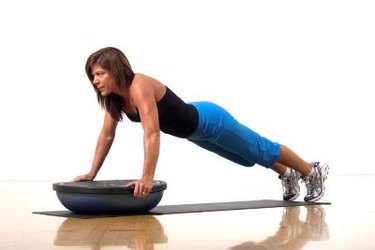
Athletes looking to increase their strength and power often incorporate both weight-training and plyometrics into their workout programs. However, scheduling your weight-training and plyometric workouts appropriately is essential to maximize the effectiveness of your training. To build strength with your weight-training session and explosive power with your plyometrics, you need to give your muscles an adequate amount of rest between each workout. The days off between workouts are when your muscles heal, recover and adapt.
Step 1

Combine your lower-body weight training and upper-body plyometric exercises into the same workout and your upper-body weight training and lower-body plyometric exercises into another workout. Schedule each of those sessions twice per week for a total of four workouts per week. Because of the intensity and volume of your workouts, allow 48 hours of rest between workouts. For example, do your lower-body weight training and upper-body plyometric workout on Mondays and Thursdays and your upper-body weight training and lower-body plyometric workout on Wednesdays and Saturdays.
Video of the Day
Step 2

Begin your workouts with a thorough dynamic warmup. Warming up your neuromuscular system prior to starting your workout will improve your performance and reduce your risk of injury. Take 10 to 15 minutes to perform some light aerobics and dynamic stretches so that your body is ready to go.
Step 3

Complete your battery of plyometric exercises first. You don't want to be fatigued at all when you're doing plyometrics, so schedule them at the beginning of your workout. Compile a battery of three to five plyometric exercises and do two sets of eight to 10 reps each. When focusing on the lower body, choose from jump squats, box jumps, rim jumps, cone hops and bounds. To develop power in your upper body, choose from medicine ball smash, medicine ball chest pass, plyo pushups and medicine ball twist and throw.
Step 4

Take a couple of minutes to rest, and then immediately move onto your weight-training exercises. Select four exercises for each workout. For example, when you're focused on the upper body, a workout could consist of bench press, rows, military press and pullups. Work all of the major muscles in your lower body with squats, lunges, deadlifts and stepups.
Things You'll Need
Weight-training equipment
Plyo box
Medicine balls
Tip
Be ready with a post-workout meal. Consuming a meal consisting of protein and carbohydrates within 30 minutes after completing your workout will significantly help with recovery. Toast with peanut butter is a quality meal to have after your workouts. If you can’t get home within 30 minutes, pack a protein bar in your bag to eat after your workout.
Warning
Perform plyometric exercises on a softer surface, such as a basketball court, tennis court or grass, and land softly from jumps to reduce the stress on your joints. When beginning a new workout program, visit your doctor for a check-up to ensure you’re healthy enough for more intense exercise.
Video of the Day